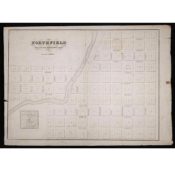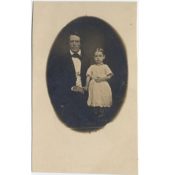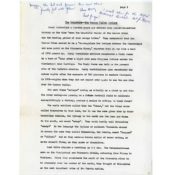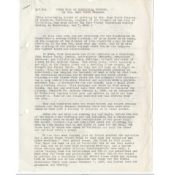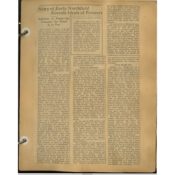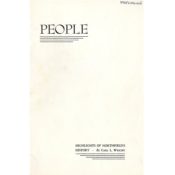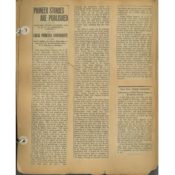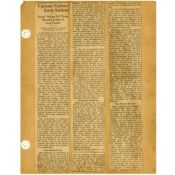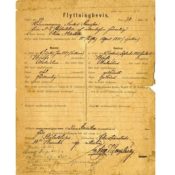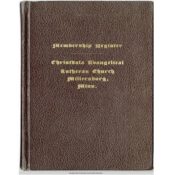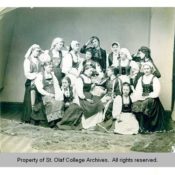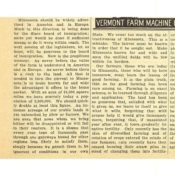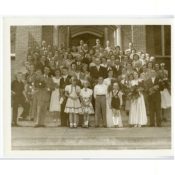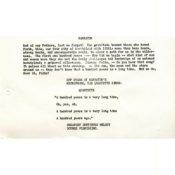
By Stephanie Hess, Northfield-Rice County Digital History Collection, January 2019
John W. North founded Northfield in 1855. He was not the first person to move to this area, nor was he the last. Over the years, many people have lived in the Northfield region. They shared similarities and differences, but they all called Northfield home.
The first people to live in Rice County called themselves the Wahpekute. This band of Dakota people met a few white missionaries and fur traders during the first half of the 19th century. When the Minnesota Territory was formed in 1849, more white settlers came and began clearing the land for pioneer farms. In response, leaders of the Wahpekute joined other Dakota leaders to sign the Treaty of Traverse des Sioux in 1851. This treaty transferred almost 30 million acres of land to the federal government and opened the area to white settlement.
When John North first came to the area in December of 1854, he was impressed by the water power of the Cannon River. He built a water-powered sawmill during the winter of 1855-56 and a flour mill in 1856. At the same time, he purchased neighboring land from Daniel Kuykendall, Dan Turner, and Herman Jenkins. He then surveyed the land and planned out a new town—Northfield.
John North was originally from New York. He wanted to fill his new town with people who shared a similar background. He wrote letters and newspaper articles and sent them back east to encourage people to join him on the frontier. As a result, many of Northfield’s first white settlers were from New York and New England, too. They included the town’s first merchants, doctors, and businessmen.
Immigrants from Ireland, Norway, Sweden, and Germany joined these Yankee settlers in Northfield starting in the 1860s. They chose to move to America largely because of the promise of good farmland. The Homestead Act of 1862 made it possible for these families to own up to 160 acres of land—a huge increase from back home. Many of these immigrants formed ethnic settlements in the rural areas surrounding Northfield. But others lived and worked in town.
New settlers viewed the Northfield area as a good place to live for many reasons. Some, like John North, saw the potential of the area’s lumber and water power. Others believed the fertile soil of the land would help them build successful farms. And others were attracted by this new community built on the ideals of John North, who wanted to form an intelligent, sober, and religious society.
Immigration continued in the Northfield area in the twentieth century for many of the same reasons. It followed similar patterns as immigration to Minnesota in general. People came from other areas of Europe to join the earlier immigrants. Others moved to Northfield from parts of Asia and also Mexico in search of jobs.
The twentieth century also saw the beginning of refugee settlement in Minnesota. Groups of “Displaced Persons” came from eastern Europe to escape Soviet control after World War II. Refugees fleeing more recent wars and conflicts around the world also came to Minnesota. Some of these refugees found places to live in Northfield.
Leaving a familiar home to move to a far-away new town like Northfield is a big decision. Potential settlers felt pressure to move to Northfield in two ways: with a “push” and a “pull”. Many were pushed to leave by poverty, famine, illness, and overpopulation in their homelands. They were pulled to Northfield by its opportunities for land, jobs, education, and freedom. These push and pull factors continue to influence the settlement of the Northfield area today.
Primary Sources
Discussion Questions and Activities
When you look at the individual items in the DHC, use the zoom-in tool to view details in the images or more easily read the documents. Use the tab labeled “TEXT” to read full transcriptions of the documents.
Questions
- Looking at stories of early Northfield (including ones saved in this scrapbook and other pioneer memories in this scrapbook), describe how people in Northfield lived during the first 5-10 years of the town’s existence. Compare your observations with how we live today.
- How do you think the Dakota people felt about all the new settlers and immigrants coming into land where they had lived for generations? How would you feel? What would you do? Read this paper on the Wahpekute for more details.
- Why did John North decide to build a town here? What steps did he take to make sure his town would survive? See the account of his founding of the city on page 15 of this scrapbook and his daughter’s summary of the first year of Northfield for some details.
- The settlers and immigrants of Northfield came here with cultural traditions, beliefs, and habits. Did they try to maintain these traditions in their new town? Did their traditions change? Can we see evidence of their various cultures in our community today?
- Why did people migrate to Northfield during the late nineteenth and early twentieth centuries? What made their journey easier? What made it more difficult?
- Imagine you are a new immigrant to Northfield. You do not speak English yet. How would you find a job, a place to live, people you could relate to? Think about community-building places like churches, schools, boarding houses, ethnic neighborhoods, and more – like the examples included in this set.
- How do we know so much about the people who came to live in Northfield? Think about some of the examples in this set, like the migration form, church membership book, the Old Settlers Association records, and even this book on significant people from Northfield’s history. What are some other ways to learn about people who moved to Northfield in the past? Why do we keep these records?
- Explain the “melting pot” process described in the newspaper article starting on page 35 of this scrapbook. Do you think this accurately describes what happened to the various immigrant groups in the Northfield area? The article was written in 1933. Does that change your perception of it?
- Explain the similarities and differences between immigration to a place like Northfield in the 1800s compared to the 1900s and even today.
- How have attitudes toward immigrants changed since Northfield was founded in 1855? Why do you think high school students were debating immigration almost 100 years ago (see the 1923 Periscope in the set above). Would the debate be any different today?
- What is the difference between an immigrant and a refugee?
- In 1955, Northfield celebrated its 100th year by putting on a centennial pageant. This show celebrated the founding and growth of the town. Episode 3 focused on the various immigrants who came to live here. One character proclaims that “We are no longer Irish, Germans, New Englanders, Scandinavians, Czechs, Bohemians, … we are AMERICANS”. What do you think about that? Do you think this is how people felt about themselves in 1955? What about today?
Classroom Activities
- Identify and locate on a map or globe the origins of different groups of people who came to Northfield. Mark these positions on the map. Create a timeline of when different groups arrived. Describe why and how they came.
- Come up with a list of 5 questions about the immigration and settlement of the Northfield area and try to answer them using the text and images in this group of sources. If you cannot answer them well only using this set, check out some other sources on the Northfield-Rice County Digital History Collection, in your library, or elsewhere.
Related Items in the Northfield-Rice County Digital History Collection
Early Northfield History scrapbook, by Emily Bierman (see especially page 17, 71, and more)
Personalities in Northfield History
Growth of Northfield in Seventy-Five Years, by Frances Bishop
Biography of Solomon P. Stewart
Heatwole’s Dairy Paper, Vol. II, No. 10, Page 13, article on welcoming immigrants to become farmers
Current Events Club of Northfield, minutes from Dec. 11, 1953, when a program on immigration and refugees was given.
Sketch of east side of downtown Northfield
Char’s Program – audio program on early Northfield history
Additional Resources
Lesson Plans
Finding a Home Lesson Plan. Developed for Ellis Island National Museum of Immigration by the National Park Service, U.S. Department of the Interior. List of other curriculum materials for this site are listed here. There are other online resources on this site, too.
Immigration: Challenges for New Americans. Primary Source Set developed by the Library of Congress.
Immigration: Stories of Yesterday and Today. Lesson plan developed by Scholastic, Inc., ©2018.
Immigration Lesson Plans. A link compilation from the Library of Congress.
They’re Coming to America: Immigrants Past and Present. Developed by the LAB@ Thirteen for the PBS series FACES OF AMERICA, 2010.
Bibliography
Carlin, Lynn, ed. and Jim Bohnhoff, visual ed. Continuum: threads in the community fabric of Northfield, Minnesota, sponsored by the Northfield Bicentennial Committee. Northfield, MN: The City of Northfield, 1976.
Clark, Clifford E., Jr., ed. Minnesota in a Century of Change: The State and Its People Since 1900. St. Paul: Minnesota Historical Society Press, 1989.
Curtiss-Wedge, Franklyn, comp. History of Rice and Steele Counties, Minnesota. 2 vols. Chicago: H. C. Cooper Jr. and Co., 1910. Accessible online as of 2018-05-01: Volume 1 and Volume 2.
Holmquist, June Drenning, ed. They Chose Minnesota: A Survey of the State’s Ethnic Groups. St. Paul: Minnesota Historical Society, 1981.
Larsen, Arthur J. “The Settlement and Development of Rice County, Minnesota, to 1875.” Unpublished M.A. thesis, University of Minnesota, 1931.
Meshbesher, Samuel. “Norwegian Immigration to Minnesota.” MNopedia, Minnesota Historical Society. Web (accessed August 29, 2018).
Neill, Edward D. History of Rice County, including explorers and pioneers of Minnesota and outline history of the state of Minnesota. Minneapolis: Minnesota Historical Company, 1882. Available online (accessed May 1, 2018).
Northfield Heritage Preservation Commission. Northfield: The History and Architecture of a Community. Northfield, MN: Northfield Printing, 1999.
Our Story: A Guide to the History of Northfield Minnesota. Northfield, MN: Northfield Historical Society Press, 2013.
Ratsabout, Saengmany. “Immigrants and Refugees in Minnesota: Connecting Past and Present.” MNopedia, Minnesota Historical Society. Web (accessed February 13, 2019).
Rice County Families: Their History, Our Heritage. Faribault: Rice County Historical Society, 1981.
Stork, Dr. Harvey E. “Big Woods Played Part in Trend of Early Settlement.” Northfield News, March 2, 1934; Page 7.
Primary Source Analysis
Here are some tips for analyzing the primary sources found above and throughout the DHC. For each source, ask students to indicate:
- the author’s point of view
- the author’s purpose
- historical context
- audience
For inquiry-based learning, ask students to:
- explain how a source tells its story and/or makes its argument
- explain the relationships between sources
- compare and contrast sources in terms of point of view and method
- support conclusions and interpretations with evidence
- identify questions for further investigation
Additional Tools
- Document Analysis Worksheets from the National Archives
- Teaching with Primary Sources Videos and Sets from the Minnesota Historical Society
- Using Primary Sources from the Library of Congress
Minnesota Education Standards
Here is a list of education standard codes for benchmarks that can be explored using this Primary Source Set.
- 0.4.1.2.1
- 1.4.1.2.1, 1.4.1.2.2, 1.4.2.4.1
- 2.4.1.2.1, 2.4.2.4.2
- 3.4.1.2.1
- 4.4.2.4.1
- 5.4.1.2.1, 5.4.1.2.2, 5.4.2.3.1
- 6.3.3.6.1 , 6.3.4.10.1, 6.4.1.2.1, 6.4.4.18.1, 6.4.4.18.2, 6.4.4.20.2, 6.4.4.22.3, 6.4.4.23.1
- 7.4.1.2.1, 7.4.4.20.2
- 9.4.1.2.1, 9.4.1.2.2, 9.4.4.16.5, 9.4.4.20.2, 9.4.4.23.3
- 1.8.7.7
- 2.8.7.7
- 3.2.7.7, 3.6.2.2, 3.6.7.7, 3.6.8.8, 3.8.2.2, 3.8.7.7, 3.8.8.8
- 4.2.7.7, 4.6.2.2, 4.6.7.7, 4.6.8.8, 4.8.2.2, 4.8.7.7, 4.8.8.8
- 5.2.7.7, 5.6.2.2, 5.6.7.7, 5.6.8.8, 5.8.2.2, 5.8.7.7, 5.8.8.8
- 6.12.1.1, 6.12.2.2, 6.12.4.4, 6.12.7.7, 6.12.9.9, 6.14.2.2, 6.14.7.7, 6.14.8.8
- 9.12.1.1, 9.12.2.2, 9.12.4.4, 9.12.7.7, 9.12.9.9, 9.14.2.2, 9.14.7.7, 9.14.8.8
- 11.12.1.1, 11.12.2.2, 11.12.4.4, 11.12.7.7, 11.12.9.9, 11.14.2.2, 11.14.7.7, 11.14.8.8
Send us feedback about this primary source set.
This publication was made possible in part by the people of Minnesota through a grant funded by an appropriation to the Minnesota Historical Society from the Minnesota Arts and Cultural Heritage Fund. Any views, findings, opinions, conclusions or recommendations expressed in this publication are those of the authors and do not necessarily represent those of the State of Minnesota, the Minnesota Historical Society, or the Minnesota Historic Resources Advisory Committee.

